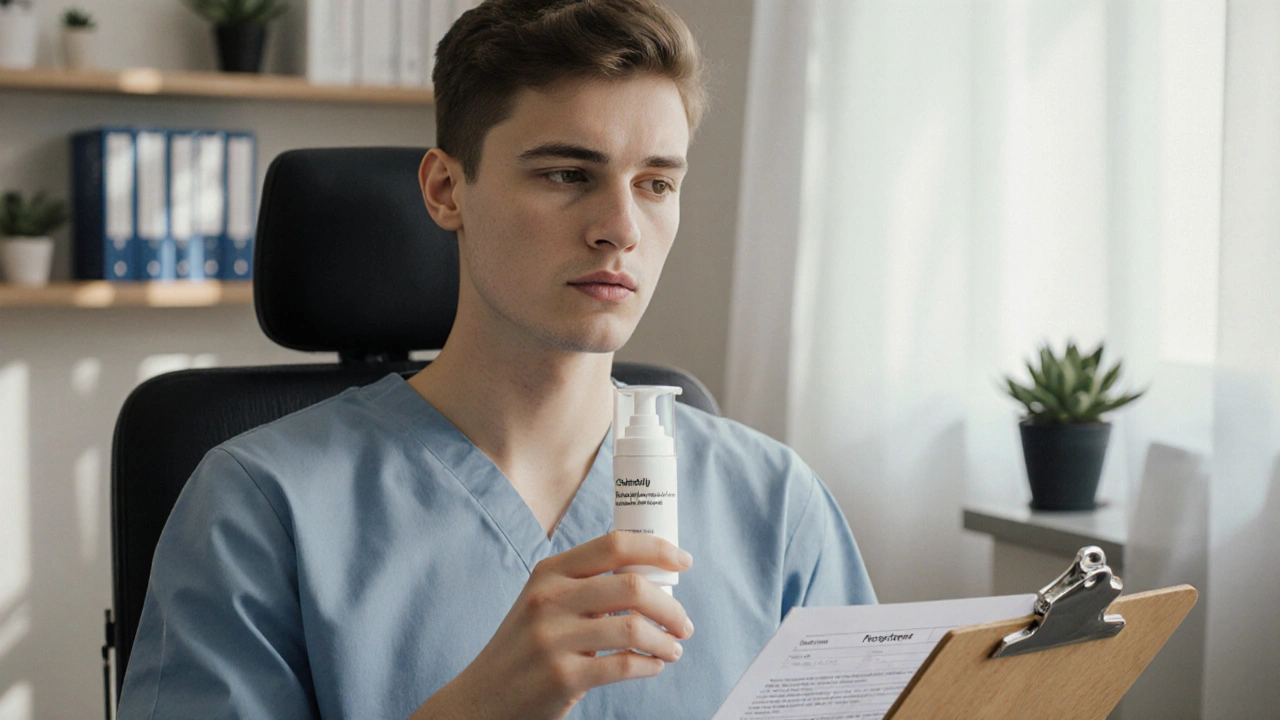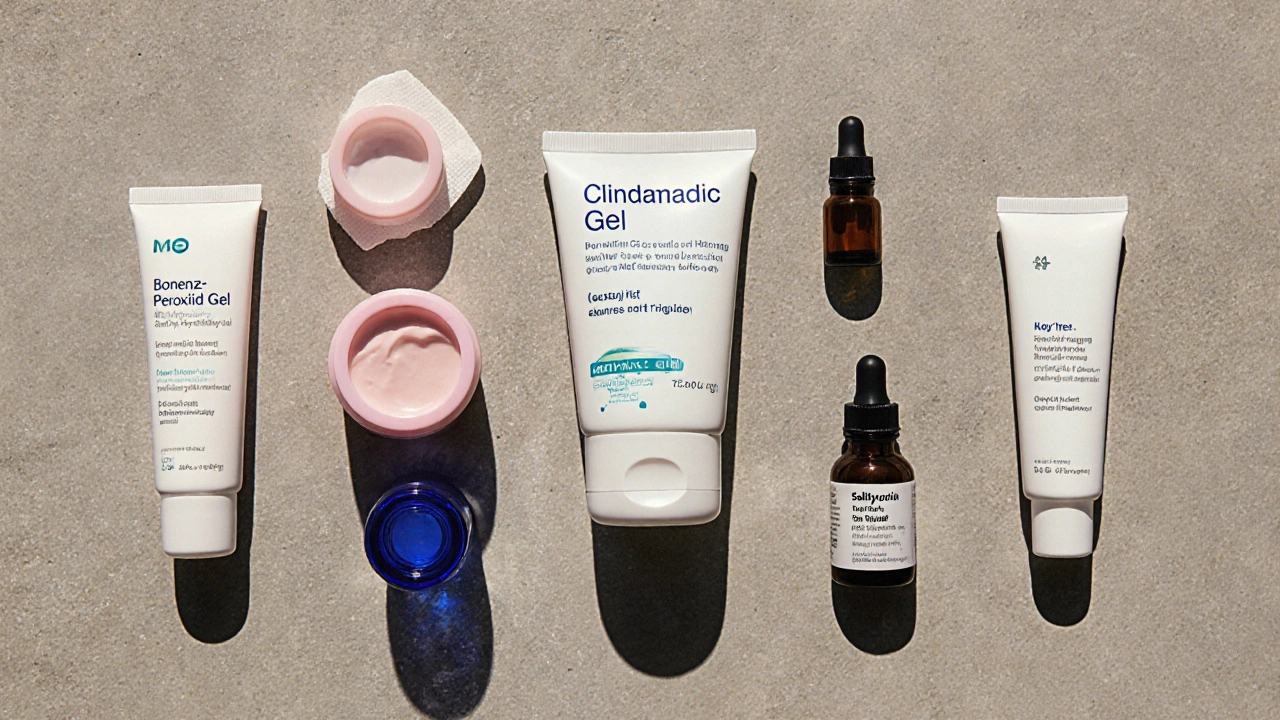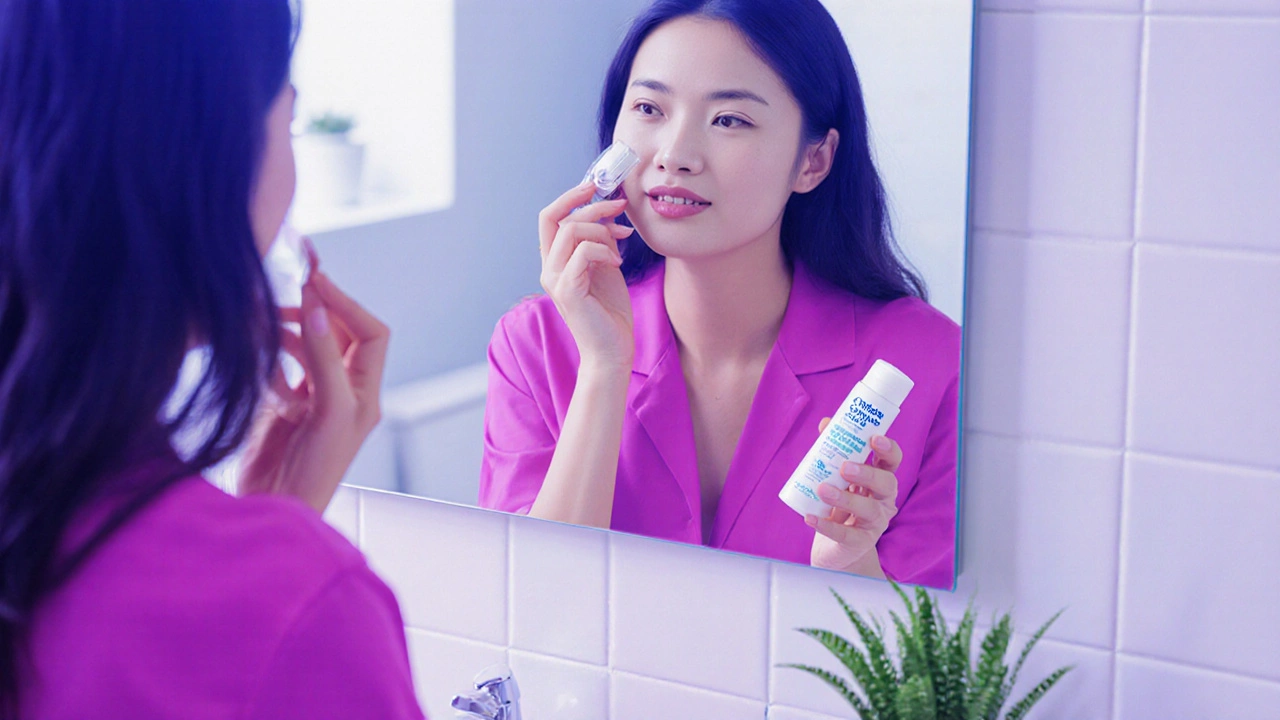Clindamycin Gel vs Other Acne Treatments: Which Works Best?
 Oct, 14 2025
Oct, 14 2025
Got stubborn breakouts and aren’t sure whether to stick with your prescription or try something new? The market is flooded with gels, creams, and pills promising clear skin, but not all of them are created equal. This guide breaks down Clindamycin gel side‑by‑side with the most common alternatives, so you can pick the option that matches your skin type, acne severity, and budget.
Key Takeaways
- Clindamycin gel is a prescription‑only topical antibiotic that targets the bacteria behind inflammatory acne.
- Non‑antibiotic options like benzoyl peroxide, azelaic acid, and salicylic acid work by killing bacteria, unclogging pores, or reducing inflammation without contributing to resistance.
- Oral antibiotics (e.g., doxycycline) are reserved for moderate‑to‑severe cases and require monitoring for side effects.
- Natural agents such as tea tree oil can help mild breakouts but lack the consistency of pharmaceutical products.
- Choosing the right treatment hinges on acne type (inflamed vs. comedonal), skin sensitivity, and how quickly you need results.
What is Clindamycin Gel?
Clindamycin gel is a topical antibiotic formulated as a 1% or 1.2% gel. It works by binding to the 50S ribosomal subunit of Propionibacterium acnes, halting protein synthesis and reducing the bacterial load that fuels inflammation. The gel base is oil‑free, making it suitable for oily skin, and it also exhibits mild anti‑inflammatory properties that calm red, painful lesions.
Because it’s prescription‑only, a dermatologist will usually recommend it for papulopustular (inflamed) acne that hasn’t responded to over‑the‑counter (OTC) options.
Common Alternatives at a Glance
Below are the most frequently used acne agents, each with its own mechanism and ideal use case.
Benzoyl Peroxide
Benzoyl peroxide is an OTC oxidizing agent available in 2‑10% concentrations. It kills acne‑causing bacteria by releasing free oxygen, which P. acnes cannot survive.
Azelaic Acid
Azelaic acid is a naturally occurring dicarboxylic acid (15‑20% cream or gel) that normalizes keratinization, reduces inflammation, and has modest antibacterial activity.
Salicylic Acid
Salicylic acid is a beta‑hydroxy acid (0.5‑2% leave‑on or wash‑off) that exfoliates inside the pore, loosening the dead‑skin plug that becomes a blackhead.
Tretinoin (Topical Retinoid)
Tretinoin is a prescription retinoid (0.025‑0.1% cream or gel) that speeds up cell turnover, preventing comedone formation and improving post‑inflammatory hyperpigmentation.
Doxycycline (Oral Antibiotic)
Doxycycline is an oral tetracycline (40‑100mg daily) used for moderate‑to‑severe inflammatory acne. It reduces bacterial growth systemically and has anti‑inflammatory effects.
Tea Tree Oil (Natural Antimicrobial)
Tea tree oil is an essential oil (5‑10% in a carrier) with documented antibacterial properties against P. acnes, though potency varies widely between brands.
Side‑by‑Side Comparison
| Feature | Clindamycin Gel | Benzoyl Peroxide | Azelaic Acid | Salicylic Acid | Tretinoin | Doxycycline (Oral) | Tea Tree Oil |
|---|---|---|---|---|---|---|---|
| Primary Mechanism | Topical antibiotic - blocks bacterial protein synthesis | Oxidizing agent - releases free oxygen | Anti‑inflammatory + keratolytic | Keratolytic - exfoliates inside pores | Retinoid - increases cell turnover | Systemic antibiotic - inhibits bacterial ribosome | Essential oil - disrupts bacterial cell membrane |
| Typical Concentration | 1% (gel) | 2‑10% | 15‑20% | 0.5‑2% | 0.025‑0.1% | 40‑100mg daily | 5‑10% in carrier |
| Onset of Action | 2‑4weeks for noticeable reduction | 1‑2weeks (drying effect) | 3‑4weeks | 1‑2weeks | 4‑8weeks | 4‑6weeks | 2‑4weeks (varies) |
| Common Side Effects | Mild irritation, dryness | Redness, peeling, bleaching of fabrics | Burning, itching | Dryness, tingling | Photosensitivity, irritation | GI upset, photosensitivity | Allergic rash, stinging |
| Risk of Antibiotic Resistance | Moderate - use with benzoyl peroxide to mitigate | Low | Low | Low | None | High if used >3months | None |
| Best For | Inflamed papules/pustules, especially on face | Acne with oily skin, mild‑moderate lesions | Combination acne, rosacea‑prone skin | Blackheads & whiteheads | Comedonal acne, post‑inflammatory marks | Severe inflammatory acne, nodulocystic types | Mild breakouts, sensitive skin |
| Typical Price (US) | $30‑$70 per month (prescription) | $10‑$30 (OTC) | $20‑$45 (OTC/Prescription) | $12‑$25 (OTC) | $25‑$60 (prescription) | $15‑$40 (generic) | $15‑$35 (essential oil) |

How to Choose the Right Option
Pick a treatment based on three practical questions:
- What’s the dominant lesion type? Inflammatory papules and pustules respond best to antibiotics (Clindamycin) or oral tetracyclines. Non‑inflamed comedones benefit from keratolytics (salicylic) or retinoids (tretinoin).
- How sensitive is your skin? If you burn easily, avoid benzoyl peroxide at high concentrations and retinoids without a gradual buildup. Tea tree oil or low‑strength azelaic acid are gentler choices.
- What’s your timeline and budget? OTC gels (benzoyl peroxide, salicylic) work fast and cheap but may cause dryness. Prescription products (Clindamycin, tretinoin) cost more and need a dermatologist’s OK, yet they often deliver clearer results with fewer flare‑ups.
Best‑For Scenarios
- Clindamycin Gel + Benzoyl Peroxide combo: Ideal for moderate inflammatory acne on oily skin. The peroxide kills bacteria instantly, while Clindamycin prevents resistance.
- Benzoyl Peroxide alone: Good for early‑stage breakouts when you want a quick, inexpensive fix and can tolerate mild peeling.
- Azelaic Acid: Perfect for combination skin that also suffers from post‑inflammatory hyperpigmentation.
- Salicylic Acid: Best for blackheads and whiteheads in the T‑zone; use a leave‑on product to keep pores clear.
- Tretinoin: The go‑to for stubborn comedones and scarring; pair with a gentle moisturizer to offset irritation.
- Doxycycline: Reserved for severe nodular acne or when topical regimens fail; monitor liver function if used long‑term.
- Tea Tree Oil: Handy for occasional flare‑ups on sensitive skin; patch‑test first.
Practical Tips & Pitfalls
Regardless of the product you pick, follow these habits to maximize benefit:
- Apply a pea‑sized amount to clean, dry skin; more does not mean faster results.
- Introduce new actives one at a time, waiting 2‑3days to spot reactions.
- Use a non‑comedogenic moisturizer to counteract dryness, especially with retinoids and benzoyl peroxide.
- Never combine two strong exfoliants (e.g., salicylic+tretinoin) without professional guidance; irritation spikes dramatically.
- For any prescription, keep a follow‑up appointment every 8‑12weeks to assess effectiveness and adjust the regimen.

What to Do If You’re Not Seeing Results
If after six weeks you haven’t noticed any improvement, consider these steps:
- Confirm you’re using the correct concentration and applying consistently.
- Check for hidden irritants in other skincare (e.g., heavy sunscreen that clogs pores).
- Discuss with a dermatologist whether to add a second agent (e.g., benzoyl peroxide with Clindamycin) or switch to a different class.
- Assess lifestyle factors - diet high in refined sugars, insufficient sleep, or stress can stall progress.
Frequently Asked Questions
Can I use Clindamycin Gel and benzoyl peroxide together?
Yes. Dermatologists often prescribe the combination because benzoyl peroxide kills surface bacteria and reduces the chance of Clindamycin resistance. Apply the peroxide first, let it dry, then layer the antibiotic.
How long should I stay on Clindamycin before stopping?
Most clinicians suggest a 12‑week course. Longer use can increase resistance risk, so after three months reassess with your doctor and consider tapering to a non‑antibiotic maintenance regimen.
Is tea tree oil as effective as prescription treatments?
Tea tree oil can reduce mild bacterial load, but its potency varies. It’s useful for occasional spot‑treatment, not for moderate‑to‑severe acne where stronger, clinically tested agents perform better.
What side effects should I watch for with Clindamycin Gel?
Most users experience mild dryness or a tingling sensation. Rarely, an allergic contact dermatitis can appear-red, itchy patches that worsen with continued use. Stop immediately and see a dermatologist if this happens.
Can I use retinoids and Clindamycin together?
Yes, but introduce them on alternate nights at first to gauge tolerance. Both can cause irritation, so a good moisturizer and sunscreen become essential.
Next Steps
1. Identify your main acne type (inflamed vs. comedonal).
2. Choose a frontline agent: Clindamycin Gel for inflammation; benzoyl peroxide or salicylic acid for oily, non‑inflamed lesions.
3. Add a second, complementary product if needed (e.g., retinoid for texture, azelaic acid for discoloration).
4. Monitor your skin for 6‑8 weeks, noting any irritation or lack of improvement.
5. Schedule a follow‑up with a dermatologist to fine‑tune the regimen or address resistance concerns.
Acne can feel like a never‑ending battle, but with a clear understanding of how each treatment works, you can build a tailored plan that clears breakouts without unwanted side effects. Remember, consistency and patience are the real secret weapons.
Hanna Sundqvist
October 14, 2025 AT 22:10They dont want us to know how the pharma giants push clindamycin to keep us dependent.
Jim Butler
October 15, 2025 AT 23:26Great overview! The comparison makes it easier to choose a regimen that suits individual skin needs. Consistency and patience are truly the cornerstones of successful acne treatment. Remember to patch‑test new products and keep a gentle moisturizer in your routine 😊. Stay motivated and keep tracking progress for the best results! 😊
Deborah Messick
October 17, 2025 AT 00:43While the article offers a useful chart, it glosses over the ethical implications of prolonged antibiotic use. The medical community warns that over‑reliance on topical antibiotics fuels resistance, a fact omitted here. A more balanced recommendation would prioritize non‑antibiotic alternatives before resorting to clindamycin.
Jolanda Julyan
October 18, 2025 AT 02:00Okay, let me break this down for anyone who still thinks clindamycin is a miracle cure. First, the drug is an antibiotic, and you know what that means – bacteria can learn to dodge it after a few months. Second, the article glosses over the fact that you’re basically feeding resistant strains to your skin. Third, the price tag you mentioned ($30‑$70 a month) is a blatant cash grab from pharma. Fourth, using it without benzoyl peroxide is like locking the front door and leaving the back wide open. Fifth, the side‑effects list, though short, hides the real risk of long‑term skin dryness. Sixth, most people on this gel end up swapping to a retinoid because the results plateau. Seventh, the “moderate resistance” claim is an understatement; resistance can develop in as little as six weeks. Eighth, you’re still applying a topical that can cause allergic reactions, which the guide barely mentions. Ninth, the combination therapy suggested is over‑complicated for the average consumer. Tenth, you’re told to see a dermatologist every 8‑12 weeks, which is a recipe for more appointments and higher bills. Eleventh, the comparison table omits the fact that many OTC options have decades of safety data behind them. Twelfth, the article fails to address that lifestyle factors (diet, stress, sleep) can outweigh any topical you slap on your face. Thirteenth, the tone feels like a sales pitch rather than an objective review. Fourteenth, the “best for” column is generic and doesn’t consider individual tolerance. Fifteenth, if you’re prone to irritation, the suggested regimen will likely make your skin worse. Finally, stop treating acne like a one‑size‑fits‑all problem and start looking at your whole health picture.
Jada Singleton
October 19, 2025 AT 03:16The data presented aligns with current dermatological consensus, yet the emphasis on antibiotic monotherapy overlooks the growing resistance trends. A balanced protocol would incorporate a non‑antibiotic adjunct early in treatment. Consider rotating agents to mitigate microbial adaptation.
Kristen Holcomb
October 20, 2025 AT 04:33Hey Hanna, i get ur worries – the pharma game is real, but clindamycin can still be a usefull tool if used right. Just make sure you pair it with benzoyl peroxide so the bactria dont get comfy. Stay cool and talk to your doc about a short course.
justin davis
October 21, 2025 AT 05:50Wow!!! Another brilliant guide that tells us to *just* follow a schedule!!! Who needs personalization when you have a table??? 🙄🙄🙄
David Lance Saxon Jr.
October 22, 2025 AT 07:06From an epistemological standpoint, the dichotomy presented between topical antibiotics and oxidative agents serves as a microcosm of the broader pharmaco‑clinical ontology. When we deconstruct the mechanistic pathways, the synergy of clindamycin with benzoyl peroxide epitomizes a complementary convergence, mitigating selective pressure while enhancing bactericidal efficacy. Yet, the discourse neglects the meta‑regulatory feedback loops inherent in cutaneous homeostasis, suggesting an incomplete systems‑level integration.
Moore Lauren
October 23, 2025 AT 08:23Jolanda your long list is thorough. For most users start with a low‑strength benzoyl peroxide and add clindamycin only if inflammation persists. Keep moisturizer simple and non‑comedogenic.
Jonathan Seanston
October 24, 2025 AT 09:40Jada, your points are spot on. I’d add that a short antibiotic burst followed by a retinoid can keep breakouts at bay without overusing meds. It’s all about timing.
Sukanya Borborah
October 25, 2025 AT 10:56Kristen, your advice is littered with slang and misspellings. The guide itself is more professional than this oversimplified mumble. Stick to proper terminology next time.
Stu Davies
October 26, 2025 AT 12:13Justin, I feel your frustration 😅. The guide can be overwhelming, but there are real benefits to the combo. Keep experimenting carefully 😊.
Michael Christian
October 27, 2025 AT 13:30David, great philosophical spin! In plain terms, mixing the two treatments gives a better chance to win the fight. Stay hopeful and keep at it.
Steven Elliott
October 28, 2025 AT 14:46Moore, sure, start low and add more – just like every other skincare blog ever. Nothing new here.
Fae Wings
October 29, 2025 AT 16:03Jonathan, your advice is a ray of sunshine in this acne storm! 🌟 It really lifts my spirits.
Anupama Pasricha
October 30, 2025 AT 17:20Sukanya, while your critique highlights valid points about terminology, remember that patient adherence often depends on clear, jargon‑light communication. A balanced approach that integrates precise language with accessible explanations can improve outcomes.
Bryce Charette
October 31, 2025 AT 18:36Stu, thanks for the supportive words. Just a heads‑up – watch out for over‑drying if you stack peroxide and retinoid.